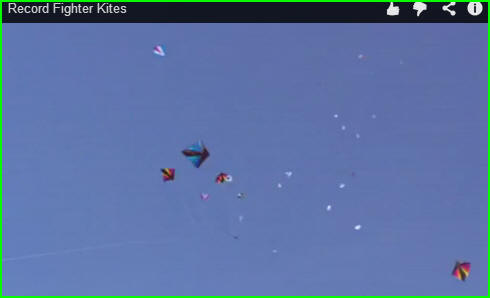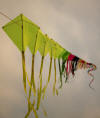Breakaway kite trains ARE dangerous.
Take every precaution to have a safe system and operation.
See:
Cluster Kite Systems |
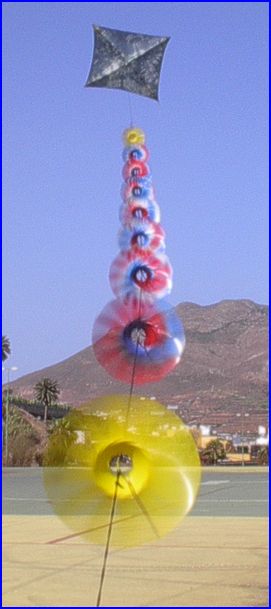
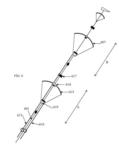
 |
Kite trains and kite stacks
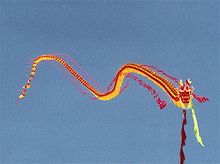 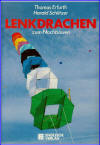
snakes, trains, dragons, centipedes, chains, beads, stairways to the sky,
ladder to the heavens, in-line stack,
Train kites have multiple wings in the kite all using the same tether
set. Tether above a wing provide some tension in the tether where a
particular wing is set. Each wing contributes to the final tension that
will occur at the kite's anchor set. The entire complex forms one kite, a
system of many wings. The train may have one anchor or two or more.
The tether set of a train may be of one tether or many tethers; some of
the tethers may be for specialized control. Control may initiate special
movements in the train parts; the movements vary from angle of attack of
the whole set of wings or just a segment of wings. Special
care to prevent breakaway of a train must be taken; inspection of the
tether set is paramount for safety. Tether sets may be tapered, but the
uppermost wing's close tether segment is to respect upper wind strengths.
Tethers may be unbroken through-put lines; or tethers may be made of
connected or connectable segments. Each segment might hold one or more
wings.
Wings of a train may be of varied shapes and sizes and types. Some
organizations restrict some records for trains to specialized definitions,
but one is free to establish new categories of train kites. For
example, one org might want to restrict trains to having identical
same-sized and type of wing for all the wings of the train; that
restriction then forms a train category. Feel free to explore your own
categories of trains. Perhaps another wide-view org will open record
categories for each type of possible train kite! Keep things open,
interesting, creative. Perhaps someone will want to have every wing in a
train be of a unique type and of a distinct size. Perhaps another person
will construct a train that tapers sizes with a big wing near the ground
and a tiny wing at the top in order to give the illusion of reaching the
heavens with the segments seeming to disappear; not everyone needs to know
that the upper wings are tapered to tiny!!! Fun.
Discuss:
AirborneWindEnergy/message/9941
In a train, the question arises about the wings involved: Would the
specific wing fly on its own or not?
Turbined train kites may have a working
generating electric turbine as the tail of each wing in a train. The
turbine would stabilize the wing while making useful electricity; the
wings would keep the turbines lofted for such work.
- stack wobble by Rod Read
12Mar2014 2: 15
DiscussHere
- arch kites stack control and
generation by Rod Read 13Mar2014 3:07
DiscussHere
-
- "Alexander Wilson, is credited with being the first European to fly
kite trains and use them for scientific purposes" WKM
- "The type of stacks of kites is based on the category of a single
kite in the stack. However Chinese dragon kites have been categorized as
dynamic-surface kites and not single-surface kites. Individual
components of a dragon kite are not designed to be flown independently.
The head of dragon kite will not fly by itself at all and the body of
the dragon would require tails to be added to create stability."
Source.
-
Eddy popularized branched
trains.
-
http://www.kitelife.com/wp-content/uploads/2012/01/Kite-Lines-v7-3.pdf
CORE ARTICLE.
-
kitebuilder.com/billings/trains.htm
- Interesting kite Santa Monica
beach near venice california Seems to be a
branching train. And site seems to be Santa Monica, CA, not the titled
Venice.
-
windlove.net/english/makekite/kite_train.html
- My EO6 kite train
0:32 Three EO6 kites under lead of a
pilot kite, it seems. "EO" :: Expandable Object
- 50 Kites!
-
http://www.ict.griffith.edu.au/anthony/kites/diamond/train_kinchloe.jpg
- "Kite
trains may be great for towing boats along trade routes."
~ Harry Valentine, 31Jan2014
-
kiteplans.org/pln_1179/ Several plans for
kite trains.
-
woot.com/offers/kite-train
-
kitesinthesky.net/resources/kite-train.php Making a
Kite Train
-
- Mini Kite Train
at LittleKites.com
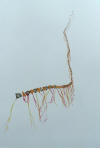 Count: 101, each about
3 inches.
Count: 101, each about
3 inches.
- Page:
http://imgur.com/a/y1AUf
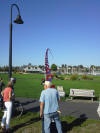
- [done, see left] Post DougS train of spinners on this page. It is on
Stakeholders' page
-
kites.co.nz/pdffiles/World%20kite%20records.pdf
-
kiteimages56 Discuss the shown train.
- "Under the direction of Kinji Tsuda, the Hiroshima Kite Club set the
record recognized by the Japanese Kite Association. The 13"x13" (34 cm x
34 cm) Diamond Eddy-shaped kites were made of bamboo spars with plastic
sail material." Magnificent Book of Kites - 02 edition
by Maxwell Eden
In Japan, 2,233 kites were flown on a single line.
[ ]Verify. BUT THIS HAS BEEN EXCEEDED; see below on page.
- Team flying stunt kite trains
-
howtokites.com/2012/10/04/kite-train-flying-is-for-all-kinds-of-kites/
- "When
you put a kite train together, it is called
stacking kites. "
- "In 1978, Kuzuhiko Asaba flew 4,128 kites on a single line."
[ ]Verify But
this has been exceeded; see below on page.
- Most wings kited on one line?
- "Another record states the largest number of kites flown on a single
line is 11,284. This record is held by school-aged children in Japan"
[ ]Verify
- "On April 4, 1975, a world record was
set by Kazuhiko Asaba of Kamakura,
Japan, for the most kites fl own on a single
line--1,050. Since then the record
has been broken a number of times.
The current record is 11,284 kites on
one string."
[ ]Verify
-
The "No Secrets" Handbook of Single Line Kite Trains
- Distinguish between very-low L/D line laundry chains from higher-L/D
wings in train or chain or tree. Line laundry items could be
working turbines for generating electricity or torque for tertiary
purposes.
-
Easy Kites for Kite Trains
See differently
kite trees,
kite coteries, kite arches, kite clusters, gatherings, formations,
collections, flowers, simultaneous multiple singles ...
|
|
Train of arches? |
Two wide set trains? |
|
Notes |
- Split wing for add ons
- Line stoppers
- Hip harness, not chest.
- AoA vs loop downing line
- R-C train?
- Two-line trains
- Three-line trains
- Four-line trains
- Kite organized. Keep tails clear. Keep lines untangled.
- Padded handles
- Two-line control stacks: land to the edge of the wind window.
- Consider piezoelectric tails
- Consider generating turbine tails
- Consider Pierre Benhaïem for groundgen
- Edge locks or edge connects. Consider split bottom for
mid-connect. Just add wing to existing lines.
- Faust described in AirborneWindEnergy about downwind kite train
arches in contrast to crosswind arches. And some variations all
the way to dome meshes of kites.
- Various schemes of using kite trains in energy production systems.
- Ladder to the sky for skydiving and hang gliding.
- Stunt trains
- Yo-yo Train to drive ground-stationed electric generator or pump or
saw or grinder.
- Train to pull generation cabled-constrained cart
-
- ?
|
|
Explore experimental |
- Side-by-side single-line trains. Film the interactions and tangles.
Explore two trains at set distances. Then go to three trains. Then four.
then five. Explore whisker spreaders. Explore veering sets within the
stable sets.
- Two-line train of foam plates tensed with major lifter wing. Aim for
no tailing for the plates. Film the result. Tether tension increases to
control the lower plates. How will the aggregate plate
challenges affect the whole system?
- Needle and thread: sew into main tether a loop of line which holds a
bead. Slip a split wing onto the tether; let the bead will be a stopper
preventing the wing from sliding u tether. The wing might have a snap
receptor to snap grasp the bead. Explore this more. This
leaves main tether without knots or loops. [ ] CARE FOR THE CHAFING WEAR
OF THE MAIN TETHER FROM WING PARTS; PERHAPS A SHEATH IN THE AREA; Slip a
helically split piece of vinyl where the bead and wing spars would rub
the main tether. PROTECT THE MAIN TETHER FROM WEAR. .
- Faust Stack Control Bars: Circle Bar. Long bar,
say 12 ft. to hold multiple line collectors. Mount multiple trains along
theCircle Bar or along the Long Bar. Observe he traffic and
interference in different winds and with different pilot wings. Also,
consider hoop lines used between trains in the train groups.
August 10,2013. Joe Faus. Give oer to public domain arts.
- Various ways to have tapered tethers.
Segments is one way. original manufacture is harder. Some rule on
segments: Say every 20 wings, increase the tether to maintain a
safety factor.
- Segments of line. Segments may be of slightly stronger line than the
segment down the line. But be aware that the topmost segment is to have
a safety factor relative to the reduction of knotting and the stronger
upper winds. The macro picture results in a tapered tether. And a
particular wing with its segment tether could be changed out easily.
- Classroom-count Team Train. Say 20 or 24 or 30 or 40.
Each student decorates a wing for the train kite.
- Kite train for HG lifting-launching. The ambient wind is
already facing the pilot. Split the tether to open the frontal window
for the pilot. Release down away from the meeting point of the two
tethers. First set the Lifter Train into skyhook mode; have split
tether to two anchors. Have AoA control of the wing set for downing the
system; have also a second downing safety line from the upper wing to a
third anchor for mitigating breakaways. Once the system is flying
well, then pull the hang glider with pilot up into the air by use of a
cord through a lofted pulley. This is different from
dropping from a free balloon, as in a free balloon, the hang gliders do
not experience an ambient wind. Assurance that the hang glider
pilot can stay weathercocked during the ascension in the kite train
system is important.
A second method is to have a kite
train lift a runway ramp. Have the system flying and then pull up the
hang glider to the ramp. Then the pilot runs the ramp into the
ambient wind and launches almost normally. The ramp will be perforated
to let air through, so some "slope lift" will be absent.
A powered winch could help lift the hang glider and
pilot to altitude. Or a team of club members. If a set of
pulley was used to reduce the tension needed to left, then one person
could run the line to lift the hang glider and pilot.
-
|
|
WORKING YET |
-
There is the very real challenge of a kite
train experience more wind than wanted!
Recall that unless a system has an angle-of-attack control or some other
means to de-power the wings, then reverse
reeling may put the system under even more stress. Consider also whether
one has room to run towards the wing set to
depower. Consider walking down the system rather than reeling in the
wings; have a fixed anchor and then walk the line
down; consider depowering the wings brought down. Also, consider an upper
drop line that brings down the upper wings in
a downwind arch; then depower the wings from the top down once the top
wing is pulled down. Consider also radio-control
devices that would lower the power of each wing in the wing set. Stay
aware of weather changes. Bring the system down
before urgency occurs.
-
Stack of Revolution kite 3:23
Seven wings in the stack. Wings are tailed for visual effects.
Four-line control. Two lines per separate handle.
-
A Very Special Kite!
This very unusual kite which was being flown at the Marina Barrage
delighted many who were enjoying a day out in the
sun.
-
Three Radian delta kites
-
Sky Delta kites
Three wings in train.
-
Light Hearted Kites
Six Revs in stack.
-
Amazing Kite Control I
Five Revs in stack.
-
MODERN
CREATIVE KITES TRAINS
-
25 Flexifoil Stackers 6' by Paul Thody - Portsmouth 2008
-
2012 B2 Stack Play
Five Revs stacked.
- SEEK STACK OF ROTARY WINGS
SEEK STACK OF ROTOR WINGS
- Consider one control bar hold two trains, three trains, four trains, five
trains.
- Consider one control bar that holds a set of trains. First train: one
wing. Second train: two wings. Third train: three wings,
etc.
-
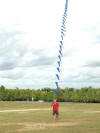
- Consider one control bar that holds a set of trains, say seven trains where
the far left and far right trains have seven wings
in each stack; then the next matching pair have five wings; then the next
matching pair have 3 wings; and then the center
train of 1 wing.
- Consider one control bar with sine wave set of trains: 7, 5, 3, 5, 7, 5,
3, 5, 7
Consider one control bar with a set of 10 trains of 10 wings each; have in
the decoration a programmed design of kixels that
say something or shown something.
Cosider free-flight inhabited of a stack of 10 wings with controls.
-
Revolution kite stack - xmas wrapping paper - Frejus2007
Three Revs in stack.
-
World Record Flight of Micron Kites Vid: 6:57
Fifty wings in the two-line stack.
-
3 great Flexfoil Power kites stacks - Team Impossible - at the Berck Vid:
4:21
Three pilots near each other have a stack kite of seven Flexifoil wings.
-
Flying the Micron 5 stack SINGLEHANDED ! Vid: 1:10
One hand on control bar. Two-line sport kites in stack. Five wings.
-
Hawk's Stack of Single Point Jessy Kites Vid: 1:16
Four wings.
-
Jumps with 4 stacked Flexifoil powerkites Vid: 1:52
-
http://www.papirsarkany.hu/images/sarkany.jpg Still photo
of train
Some still images:
|
|
AWES and trains |
A. van Gries promoted trains and coteries for
lifting turbines. See full patent and discussion.
AirborneWindEnergy/message/5112
Tailed turbines in Train
AirborneWindEnergy/message/9904 |
|
Samuel Perkins |
|
|
Found in August, 2013 |
|
|
Failure modes explored and mitigations also |
Bi-Conductive Dual-Tether Kite-Stack Major Failure-Mode
Posted By: santos137 Sat Aug 17, 2013 10:02 pm |
The AWES Forum has covered the subject of kite stacks (a close-spaced
train) in AWE in numerous messages. We trace our modern era to Dave Culp's
Flexi-stacks pulling Tornado catamaran decades ago. He found stacks a
nightmare, and came to champion giant mono-kites to pull ships. Since
then, many AWE stack concepts have been shared and some tested (note
PierreB's OrthoKite Bunch), with single trains now giving way to arches
and domes. Expect to see many short stacks under arches, if the
evolutionary trend in our R&D circles holds.
The primary failure mode of a two-tether kite-stack, with each tether
as one of a conductive-pair, is a twisted-tether short-circuit. Tall
stacks are not very stable and tend to dance harmonically to the extent
the kites have mass, are closely-spaced, and similar. In rising wind,
this "crosswind-strum" builds, and an irresistible twist
is probable. Stacks are also quite hard to launch and land by
automation, but Doug is welcomed to solve this bottleneck, if he thinks he
really can.
Here is one of my personal Kite Masters, Gary of the Detroit Windjammers,
the team that gave me great hands-on stack training, like this video can
do for you-
Advanced stack flying
[[ Gary Maynard as PIC ]]Comments:
- The challenges mentioned may be opportunities. Exploring possible
mitigations and alternatives will reveal new opportunities.
- The wings of a kite stack need not be of the same mass or same
flying characteristics.
- Dave Culp's stacks did not seem to have a remote upper lifter; the
purpose of his stacks seem to have been traction.
- The "closeness" of wings in a stack is relative; the distance
could be less than a span of a wing involved or more than a span, etc.
All options may have interesting qualities.
- Kite stacks need not be flown cross-wind. If a stack is
itself the lifter of WECS where the WECS have elements flying to
crosswind, then new avenues open.
- Look for how to face thermal-caused twisting in trains and stacks.
Could a stack be controlled to avoid thermal-initiated twists. The
tornado-like helicities might be flown out of or maybe even mined for
twist; I am leaving open this realm for study.
- By "conductive" usually means electrically conductive unless
otherwise noted. Conducting mechanical translation or torsion are two
other ways energy may be conducted in tether lines. Also, lines
might conduct gases or liquids or high-frequency mechanical
vibrations.
-
- v
- v
- v
|
|
France's Captain Dorand's kite trains ???? [ ] and more. |
|
|
England's early kite ascensions ??? [ ] |
|
|
Terms used in kite trains |
pilot kite, head kite, carrier kites, top of train, bottom of train,
arch trains, |
|
Jacques-Théodore Saconney |
-
http://en.wikipedia.org/wiki/Jacques-Th%C3%A9odore_Saconney
- Cerfs-Volants Militaires: Théorie pratique de cerf-volant cellulaire
et des trains de cerfs-volants. Berger-Levault : 1909
- Title Cerfs-volants militaires...
Author Jacques-Théodore Saconney (Général.)
Publisher Berger-Levrault, 1909
Length 94 pages
NO EBOOK YET.
|
Aerial Military Photography
by Kites and Balloons
1902 - 1915 |
|
|
Some train items |
|
|
|


|
|
|
Al Hargus |
|
|

The Aeronautical Journal, Volumes 1-7
|
|
|
http://www.wright-brothers.org/History_Wing/History_of_the_Airplane/Doers_and_Dreamers/Doers_and_Dreamers_images/Hargrave/Hargrave_kite_train_1896.jpg
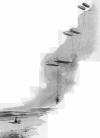 |
|
|
Welcome to KiteTrains
This room is for appreciating and advancing the kite-train sector of
kiting. Purposeful kite trains are importantly part of the rumble as kite
energy faces the need for clean and sustainable renewable energy. Working
loop trains or loop laddermills have yet to show themselves. Methods of
train handling is a growing sector. Over-pressure strategies will
challenge developers. "Flying rope" beckons mastery. And much more!
Centipedes, segmented dragons, tight trains, sparse-wing trains,
single-line trains, two-line trains, three-line trains, four-line trains,
n-line trains, wide trains, narrow trains, tapered trains, hybrid trains,
branching trains, trees, coteries, n-anchored trains, loop trains,
cross-winding trains, train turbines, inhabited trains, ... and more
invite mastery from which may give birth to successful task achievers and
energy providers.
Share what you know. Show your projects. Ask questions. Help others with
answers. Stay safe. Protect others' property and life. Have no breakaways.
When flying FFAWE trains have the smarts and airspace permissions needed
for a fully safe flight. Form teams to cover contingencies. Tell us about
your successes and incidents.
Best of drags and lifts,
JoeF |
|
|
Drachen Foundation on Eiji Ohashi
http://www.drachen.org/bio/eiji-ohashi
|










